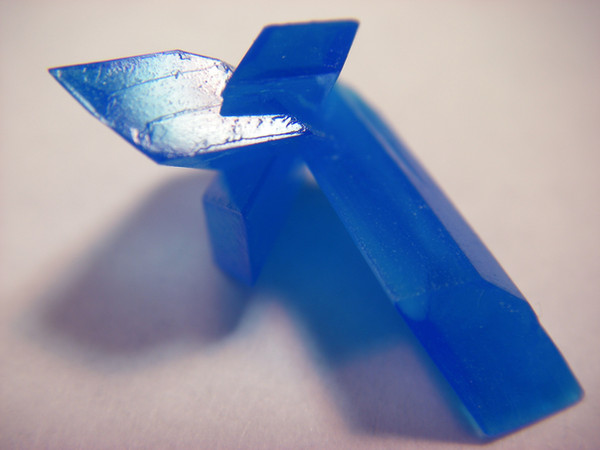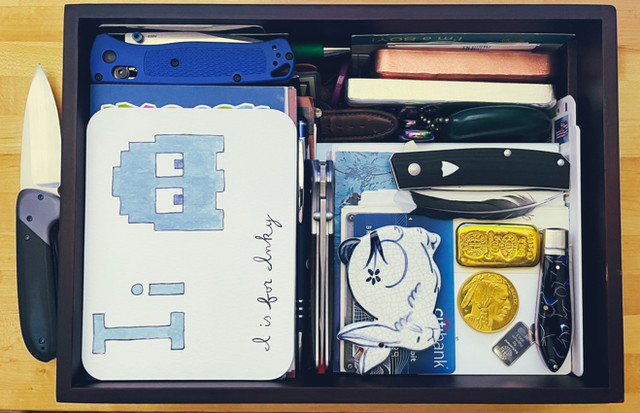HOME | DD
 BorosilicateArachnid — Chalcanthite
by-nc
BorosilicateArachnid — Chalcanthite
by-nc

Published: 2007-05-15 06:30:22 +0000 UTC; Views: 897; Favourites: 16; Downloads: 21
Redirect to original
Description
Lab (read: glass baking dish in an old toaster oven in the garage) grown "Chalcanthite" crystals. CuSO4*5H2O. I salvaged a few nice crystals from the last recrystallization batch of a 2lb canister of crude Copper sulfate pentahydrate (99% pure wasn't good enough for me)My camera has such issues photographing bright blues. What I see isn't what I see through the camera's viewscreen. What the photograph on the viewscreen looks like isn't what I saw on the viewscreen before I took the shot. What I see on the computer later on is dramatically different from all of the above. So....I putzed with the exposure and color saturation to try to make it look the same as if you were looking at it directly.
Related content
Comments: 14

Wow. Now that's a crystal I would love to have in my collection. Was it fairly easy to grow it? How much water did you use?
👍: 0 ⏩: 1

These are very easy to grow crystals. Most sources of copper sulfate (except reagent grade) will have a little insoluble gunk in them. I dissolve it in as little water as possible plus a little more (to stall crystallization once the heat is removed, so that it can be filtered). After cooling, I pour the liquid off of the solids, boil that down to some arbitrary point and cool to collect more solid.
If the cooling is done with an absolute minimum of disturbance and preferably at a slow rate, you will form large crystals. In the case of needing to filter first, I would reheat it to redissolve any solids, wrap in towels and leave it in a very still, cool spot. Make sure to use a container that you can actually get the crystals out of- shallow and with a wide opening is ideal.
Slow evaporation of a solution can also produce very large crystals- much larger than you can get by cooling a hot solution. Add more copper sulfate than you can get to dissolve to water (it dissolves very slowly, heating it up and letting it cool back down helps), then pour off (and filter if needed) the solution. Add a single small seed crystal, cover the container with paper towel to keep out dust but let water evaporate, and set aside for a while in a warm spot.
👍: 0 ⏩: 1

Thanks for the tip bro. I think this might even help me through some courses in college.
👍: 0 ⏩: 0

What solvent did you recrystalize in? Those are really nice, by the way, way larger than one usually sees. And why'd you need pure copper sulfate pentahydrate anyway?
👍: 0 ⏩: 1

Just water. It is virtually insoluble in any other common solvent. It is several times more soluble in boiling water than in cold water. So I heated to boiling in a toaster oven, reduced by at least half, and let it cool overnight. I woke up to a whole pan full of crystals and a few hundred milliliters of liquid left.
I needed it because I like to play around with chemistry (and I'm neurotic). Copper sulfate makes a nice segway to other copper compounds since it is readily converted to carbonate or hydroxide (chloride would prefer to make oxychlorides and nitrate is hard to lay hands on). I also use a number of the chemicals on hand to put finishes on metalwork. For example, a copper salt mixed with a chloride source attacks aluminum, giving it a patchy, aged look.
👍: 0 ⏩: 1

Ahh, ok. I've never done a water recrystallization (ya know, aside from sugar back in junior high), I've usually used some mixture of ethanol and ethyl acetate, or else a mostly nonpolar solvent of some sort, but that's just because that's what worked for the compounds I was recrystallizing. Most of what I've worked with was insoluble in water at any temperature. Also, that was an actual class, so they had to justify the lab fees somehow
I've never tried to get my hands on nitrate salts, but seeing as there are a good deal of explosives that start with nitrates... I can see why it'd be difficult. Still, nitrates make some really nicely colored coordination compounds, and tend to be water soluble, which is always a plus.
👍: 0 ⏩: 1

Generally, they are really water soluble, which can be quite annoying since they end up hygroscopic. I have purified sodium, potassium, and ammonium nitrates on hand (If I was intent on blowing something up why would I have bothered recrystallizing...That's my line of defense). I still haven't figured out what to do with them, although they are handy as oxidizers in molten-state reactions for making things like dichromates. If you know where to look in a hardware store KNO3 and NaNO3 are easy finds. I have a large variety of nonpolar solvents as well...
I wish I had the equipment to do organics, but I'm stuck in the realm of inorganic chem.
👍: 0 ⏩: 1

Have you thought about setting up a rudimentary drying box to keep the hygroscopics in so that they don't pick up the water? We used to have these really neat sealed containers where the bottom half was full of anhydrous magnesium sulfate pellets that would absorb all ambient humidity and keep your compounds dry over the weekend so you could do labs over multiple days without having to re-dry your sample every time you got into class. Looks like you can get the hydrous form of magnesium sulfate commercially as epsom salts, and I can't imagine it'd be difficult to dry the stuff in an oven... If you then taint the magnesium sulfate with a compound that changes color from the anhydrous to the hydrous form, you have a cute way of knowing when to change the pellets out for new ones. It was quite handy.
Also, what sort of equipment are you missing? I've always wanted to get my hands on a good distillation apparatus (I'd love to extract and purify essential oils) and a separatory funnel. I figure once I get my teaching credential that should be much easier.
👍: 0 ⏩: 1

I'd need the distillation column, a hotplate/stirrer, and a few reaction flasks (3-neck). I have a rudimentary dessicator that uses Anhydrous CaCl2...I think the lab dessicators generally use anhydrous calcium sulfate (roasted plaster of paris) doped with cobalt chloride I have a canister (read: about 2 pounds) of anhydrous MgSO4 that I dried myself should the need arise.
👍: 0 ⏩: 1

I can't imagine what sort of organic reactions you'd really need 3-neck flasks for that simple round-bottom flasks couldn't handle... unless you're doing oxygen and/or water sensitive syntheses. But the distillation column and hot plate/stirrer really are a must... And if you're into purification of organics, a chromatography column might be useful.
👍: 0 ⏩: 0

really cool... could be a sharper image.. where the hell do you get CuSO4? and how big is this crystal?
👍: 0 ⏩: 1

No matter what I do, If the camera is a few inches from the sample, I can't get a decent focus range (understandably), and I don't have a macro lens anywhere. This sample is a little under an inch from tip to tip of the two big crystals. Where did I get the copper sulfate? Home Depot or most any hardware store...They sell it as tree root killer (in case they're growing in your pipes) at 99% purity.
👍: 0 ⏩: 1

Hm, what I do sometimes to simulate macro is I take the pic focused from a bit away, and then I crop it down on the computer. There's also a macro setting on my digital camera but it doesn't always work so well.
👍: 0 ⏩: 0



























